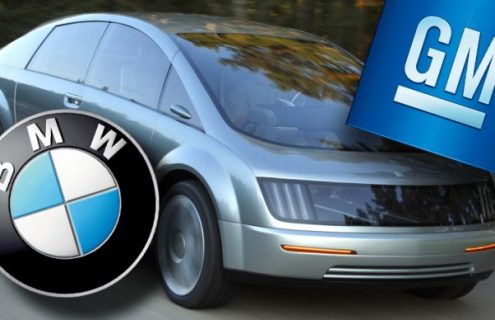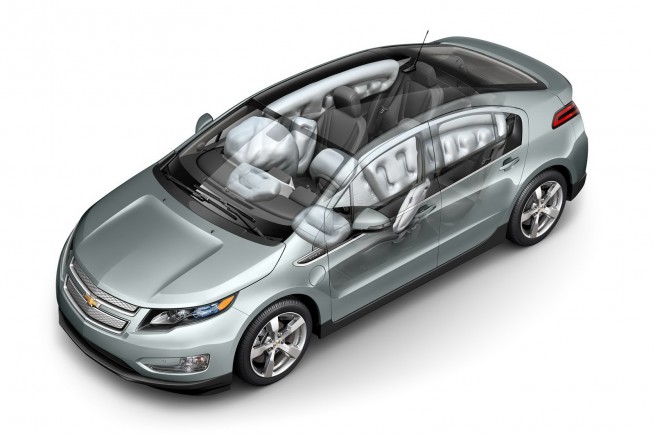Discussions about the similarities between the GM Volt and the BMW i8 have started to make their way to the discussion table. Rightfully so since Volt program leader Frank Weber left for Munich to head BMWi drive train development under Dr Klaus Draeger in April 2011. However, the timelines and technology between the 2 cars are very different but were developed together.
A little digging on the internet would have explained that BMW and GM could be working together and subsequently not be stepping on each others technologies.
The GM developed Voltec (E-flex platform) debut in production form in September of 2008 under the charge of Frank Weber. But GM didn’t develop the Voltec platform alone. GM shared development with BMW and Daimler/Chrysler for obvious reasons of keeping costs down. GM first partnered with Daimler/Chrysler in 2004 with the hopes of developing an advanced hybrid system that would compete with the likes of Toyota while giving them the ability to use this technology in trucks, SUVs and large cars. BMW joined this partnership in 2005 and the three companies opened The Hybrid Development center in Troy, MI.
In 2007 BMW and Daimler/Chrysler expanded their partnership by developing what is today the X6 ActiveHybrid and the BlueHybrid Diesel/hybrid technology for Daimler. Cerebus bought Chrysler from Daimler and the development of the two mode rollout was completely halted. After Chrysler was sold and went through bankruptcy the Advanced powertrain development was restarted. The Daimler BMW partnership ended in 2009.
The result of the BMW/GM/Chrysler collaboration was the two-mode hybrid system. The E-flex powertrain was tested in vehicles from each brand. GM went with the Tahoe, Yukon, Chrysler with the Aspen and Durango. The rollout procedure of this partnership was set up in a way that the company who had invested the most capitol and engineering manpower would get to debut the technology first, in this case, BMW.
BMW is currently using their co-developed technology in their ActiveHybrid series cars, the X6, 3, 5 and 7 series cars. At the moment, Chrysler is deploying their two mode hybrid in a new PHEV (Plug in Hybrid EV) Ram 1500 that is being tested in cities across the US.
The BMW Concept Vision EfficientDynamics debuted at the Frankfurt Auto Show in 2009, thrilling show goers with the possibility of a Green Performance BMW far before Weber left GM for Bavaria to develop Advanced Alternate Energy drivetrains. A prototype of what it will be known as the BMW i8 was previewed to a small group of journalists in November of 2010. Our very own Horatiu was given a ride in a the aforementioned prototype.
The drivetrains of the i8 and Volt are different. The Volt started life as an EV with a Range Extending engine, but conflicts within GM quickly forced Weber and his team to change the configuration so that the 1.4 liter Atkinson cycle gas engine drove the front wheels through a clutch and gear system essentially making the Volt a very advanced hybrid.
Those conflicts led to a feeling of betrayal by the Volt engineers. Here is an email excerpt from Chris Chrouch, an engineer who used to work at the Hybrid Development Center.
“When GM received word that other OEMs were working on EV vehicles, they went back to the design team and told them to change the car. The software was redesigned to not regenerate power by braking, it would only run on the power in the batteries until it was low enough that the generator (ICE) was needed. Many of the engineers on the Voltec project felt betrayed by GMs motive to change what was already a completed and perfected vehicle. It was shortly there after the head of the project (Frank Weber) decided to take his expertise and leave for BMW. This makes a great deal of sense given the Volt was using technology designed and funded by the BMW GM Daimler/Chrysler partnership.”
The BMW i8 on the other hand combines the electric drive system of the BMW i3 with an internal combustion engine. A 96 kW (129 hp) electric motor located in the front axle powering the front wheels and at the rear is a turbocharged 1.5-liter 3-cylinder gasoline engine producing 220 hp and 220 lbs/ft of torque. The result is a combined output of 349 hp allowing the i8 to accelerate from 0-60 in just 4.8 seconds. In the i8, this set up is considered a parallel series hybrid. BMW engineered the i8 to maintain a more exciting feel by having the propulsion effect of RWD.
Another factor that will separate the BMW i8 and i3 from all other green cars on the market will be the extensive use of its carbon fiber reinforced plastics.
With Frank Weber joining BMW, we will be seeing his extensive knowledge of Advanced Drive Trains come through in future BMWs.
Contributors to the article: Chris Chrouch and Hugo Becker





Author: Manny Antunes
Source: http://www.bmwblog.com/2012/03/13/the-bmw-volt/







